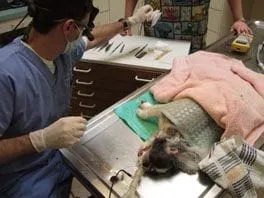Anesthesia is oftentimes the top concern for pet owners, and may be the most common reason for resisting having dental procedures performed on their pets. At The Pet Dentist, we recognize this is a legitimate concern for pet owners and we make every attempt to make anesthesia as safe as possible. The number one reason most people avoid their own dentist is for fear of pain. This is also top priority at our practice as we recognize there can be significant discomfort with dental treatments, but there doesn’t have to be.
Inhalant anesthetics (such as Isoflurane) dramatically reduce the number of anesthetic complications and allow for quicker, lighter planes of anesthesia, and much faster recoveries. Most patients are awake, standing, and walking with minimal effects of these gas anesthetics within 15-20 minutes of discontinuation of anesthesia. We prefer to monitor patients for longer than this, but the vast majority of our patients go home the same day. While this type of gas anesthesia has many more advantages, this one is what most clients will see and appreciate. The drawback to these anesthetic gases is that they provide relatively little analgesia, or pain control. For this reason, you will see that we utilize a number of pain management modalities to alleviate discomfort. We routinely use local anesthetics or “nerve blocks”, to numb an area prior to starting any painful procedure. Research shows that if we block pain before it is started, it is much easier to manage. The local anesthetic allows us to maintain the general anesthesia at as light a level as possible, usually only needed to keep the patient still. Other measures taken to evaluate the patient can also be very beneficial. We ask that all patients have pre-anesthetic complete blood count and chemistry profile be performed (usually at the referring hospital if possible) and may request further diagnostics such as chest x-rays, urinalysis, heart ultrasound, or EKG in individual cases. These tests help us to customize an anesthetic protocol and dispense appropriate post-operative medications for each patient.
Anesthetic monitoring is also an important component to any anesthesia. All patients undergoing anesthesia will have an IV catheter and are administered intravenous fluids unless precluded by other medical conditions. Patients are typically monitored by a combination of a respiratory monitor, heart rate monitor, blood oxygen level, blood pressure, carbon dioxide level, temperature and EKG. All patients are placed between two warm water circulating blankets to maintain core body temperature. Even with all these measures, one of the most important components to anesthetic monitoring is the doctor and technician. The attending doctors and nurses are monitoring heart rate, pulse quality, respiratory rate, mucous membrane color, and overall anesthetic depth at all times during the procedure. While we cannot guarantee the outcome of any anesthesia event, we take every anesthetic episode seriously and treat every patient with care by keeping them with us until they are recovered enough to walk to our recovery area on their own or are discharged to their owner.
All of our anesthesia protocols have been developed in combination with an anesthesiologist to provide the highest level of safety. Most patients, if otherwise healthy, will do very well under anesthesia and will recover without complications. As an added measure of safety for our most at risk patients, we offer the services of a Board Certified Anesthesiologist. On at least two days each month, we have an anesthesiologist in the office. We attempt to reserve these surgery appointments for the patients that are at the highest risk of going under anesthesia. Our doctors and staff will assist you in determining if, or when, we feel that your pet would benefit from being scheduled on one of these days. An initial consultation appointment with one of our doctors is required prior to the day of the procedure. Additional laboratory testing and/or diagnostic imaging may also be recommended. If deemed necessary, we will consult with your primary care veterinarian, or other specialists familiar with your pet's health history. Please feel free to discuss with us any anesthetic or pain management concerns you may have for your pet.
For additional information about the anesthesiology team that we partner with, please visit https://safeharboranesthesia.com.
'The Pet Dentist' - Location, Map, Directions. Offices serving greater Tampa Bay, Clearwater, St Petersburg, Brandon & Bradenton :

